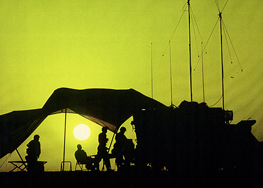U.S. Army Trains for Combat with Solar Power
 Solar-powered military units operating in war zones are the next move for the U.S. Army’s Net Zero program, which is gathering steam this spring. Last year, the Army began issuing backpack solar kits to soldiers in Afghanistan for operations on the go, and now the program is ramping it up a level with hybrid solar and wind power equipment designed to provide enough energy to help power small remote outposts.
Solar-powered military units operating in war zones are the next move for the U.S. Army’s Net Zero program, which is gathering steam this spring. Last year, the Army began issuing backpack solar kits to soldiers in Afghanistan for operations on the go, and now the program is ramping it up a level with hybrid solar and wind power equipment designed to provide enough energy to help power small remote outposts.Petroleum as the enemy of military efficiency
The Army program is separate from a U.S. Marines solar power demonstration also under way in Afghanistan, but it shares one key element: the need to cut the cost, risks, and operational drag caused by an over-reliance on petroleum products. Supply is a particularly pressing issue for remote bases in unstable regions, and according to Army writer Denver Beaulieu-Hains supply issues become even more critical as operations in a theater wind down, as is the case in Afghanistan. Fewer personnel translates into less manpower available for transporting fuel and guarding convoys, for example.
Energy to the Edge and hybrid solar equipment
The 173rd Airborne Brigade Combat Team, which is headquartered in Italy, is currently training in Germany to use the new equipment. The exercise is being conducted by the Army’s Rapid Equipping Force, under the Energy to the Edge program. The program, which was developed last summer, is designed to reduce dependence on energy and water transportation for remote bases. It consists of a high-efficiency, high performance suite of alternative energy and power management systems that can operate seamlessly on solar, wind or petroleum products while also cutting down on noise and maintenance issues.
Training for Energy to the Edge
The 173rd is training to maintain and repair the new equipment as well as to operate it, and the soldiers are also training to interact with it. According to a statement from Col. Peter A. Newell, director of the Rapid Equipping Force:
“Understanding power and energy management at the small-unit level, platoons and companies, is a cultural change and not something we’ve done in the Army. Units may experience very long logistic resupply requirements on roads that are a great threat to the Soldiers that have to drive those routes. The guy that is training the Afghan National Army is the same guy that has to secure the valleys and clear the roads for the dangerous convoy movement to sustain the COP [combat outpost] or FOB [forward operating base].”
Army as a culture warrior for clean energy
Translated into civilian terms, Newell is simply saying that energy users need to practice responsible energy management, not only for their own security and comfort but also in order to help cut the risks for those who supply it. The risks to local communities from oil drilling, coal mining and natural gas fracking are not equivalent to a combat zone but the short and long term impacts can be severe, including economic malaise, shortened lifespan and other significant public health issues. The Army’s Energy to the Edge program is a clear call for a cultural shift in attitudes toward energy consumption, and those who wave the “Support Our Troops” flag should be the first in line to support the U.S. Army…right?
You can return to the main Market News page, or press the Back button on your browser.

